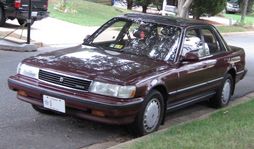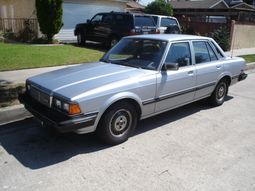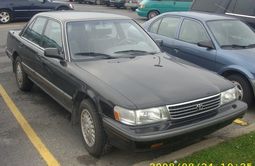The History Of Toyota Cressida

The Toyota Cressida is a mid-size, high-end luxury sedan renamed by Toyota in 1973, first exported from Japan in its second generation in 1977. It was the result of renaming the Corona Mark II in the United States. The same chassis, with slightly different bodies were available in other countries as the Toyota Mark II, Toyota Chaser and Toyota Cresta. The Cressida name was retired in 1993 (1992 in North America), but the chassis and Mark II, Chaser, and Cresta names continued production in Japan until the early 2000s.
In the United States, the Cressida was also known as a "four-door Supra", because the Supra and Cressida shared the same M series straight-6 engine, had rear-wheel drive, and were both flagship cars for Toyota North America at the time. Since the introduction of the Cressida in the USA, its primary competitor has been the Nissan Maxima.
The Cressida was available worldwide in a variety of forms and engines. Available engines included the G-series I6, M-series straight-6, and R-series straight-4 gasoline engines, as well as the L series diesel straight-4.
Japanese market tastes were generally "formal" in the mid-1980s for this segment and the Cressida followed. In 1985, the Cressida, Mark II and Chaser went slightly more upright and square, when overseas trends were beginning to move toward rounded, fluid shapes.
Because of its luxurious characteristics, the Cressida is often said to have provided the inspiration for the Lexus brand, which is a separate division from Toyota.[citation needed]
The name Cressida was used from a William Shakespere play Troilus and Cressida.
The first generation Cressida (designated MX32) was available as a sedan, wagon, and a coupe version (which was available in Japan but not in all world markets). In Japan, it was sold as the Toyota Mark II. Standard features included air conditioning (unusual as a standard feature at the time), automatic transmission (a 5-speed manual was available), power steering, rear seat armrests, AM/ FM cassette stereo with amplifier (again unusual), steel-belt radial tires, reclining front seats, and a rear window defroster. The automatic transmission was a four speed overdrive with an overdrive lockout - very unusual for that time. Power windows were optional. Soundproofing was extensive, and the Cressida was famous for being one of the quietest cars on the road at the time. The 4M-E straight-six was an SOHC unit that was both powerful and quiet, however gas mileage was somewhat of a weak point, but still better than American luxury cars of the era. Cornering was reported to be very good by standards of the times, despite a smooth ride. On the New Zealand market, where it was locally assembled and sold in a highly specified 'GL' form, the car used a 2.0 L 4-cylinder engine.
In the United Kingdom, the Cressida was available in both sedan and wagon bodystyles. The only engine available was a 2.0-litre 4-cylinder petrol and there was one trim level, badged De Luxe. Contrary to popular belief, it was not the same as DX specifications on other Toyota cars, but a more upmarket version of the DX trim level. The then-contemporary Toyota Carina sedan and wagon also sold in the United Kingdom at this time also were badged as De Luxe (but rebadged as DX from 1980 onwards).
The second generation Cressida, the MX63, was a significant redesign from the previous generation. Gone was the coupe version, but a more up-to-date body style was new for the sedan and wagon. Changes from the previous generation included a larger engine, now up to 116 hp (and using electronic fuel injection). The 5M-E would power the 1981 and 1982 models before it was superseded by the 5M-GE, a DOHC engine with a substantially higher power rating, 143hp (107kW) in 1983 and 156hp (116kW) in 1984.
In 1983, the Cressida was refreshed and gained an independent semi-trailing link rear suspension, rear solid disc brakes, and the 5M-GE engine, in order to compete more effectively with Audi and BMW. The technology was mostly borrowed from the Toyota Supra with minor differences. A 5-speed manual transmission was available, but cars equipped with it were considerably more rare than automatic versions. The electronically-controlled A43DE automatic transmission was another improvement over the previous hydraulically-controlled A43DL transmission and had 3 modes: Power, Normal, and Economy. This iteration was praised for its handling, ride, quiet interior, and most of all, its reliability; the Cressida was quickly gaining a reputation for outstanding ownership.
The North American version saw the introduction of automatic seat belts which consisted of a motorized shoulderbelt that was deployed in the closed position when the door was closed and the ignition on.
The 1984 Cressida Wagon was also crowned as Car of the Year by Motor Trend.
For 1985, a new Cressida was introduced by Toyota. The 5M-GE engine was mostly unchanged from the 1984 model year but gained a knock-sensor, which detected pre-ignition and adjusted timing accordingly when a lower-grade fuel was used. The bodystyle was all-new, larger, and more aerodynamic than previous generations. Interestingly, like its main competitor at the time, the Nissan Maxima, it was given the "compact" designation, though it had grown considerably in size. New options included were an electronic shock absorber control, with a Normal/ Sport switch that could increase shock stiffness, digital instrument cluster, woodgrain trim, and secondary radio controls that were placed right by the steering wheel for easier access while driving. The automatic transmission retained its Normal/ Power selector as many other Toyotas would, but later in production, the Economy selection was dropped; it was almost never used because of how low the shift points were. In 1987, the automatic transmission was changed to the A340E that was also used with the 7M-GE engine at the time. The 1988 model was not offered with a manual transmission and the wagon was discontinued in 1987. By 1988, power output was at 161hp (120kW).
The 1989 model year marked the final generation of the American market Cressida when the body was updated and the 7M-GE engine was introduced, resulting in power growing from 156 to 190hp (140kW). J.D. Power and Associates also rated the 1989 Cressida as one of the most reliable luxury vehicles for its time, competing with other car makers such as BMW, Mercedes, and Volvo. The 1989-1992 model Cressida was larger and more rounded than previous generations, and had even more standard features. Newer features included anti-lock brakes and a new "semi lock" transmission that did not engage out of park unless the driver put their foot on the brake pedal. As with previous generations, technology was shared with the Toyota Supra. In addition to the powertrain, the brake and suspension technology were modified versions of the Supra. The front suspension used the double wishbone design despite the rear still being a semi-trailing link. This model is what is known as the MX83, the last Cressida sold in North America. The Cressida was discontinued in North America in 1992; the introduction and success of the Lexus division meant that Toyota no longer needed a large luxury sedan in its lineup. The Cressida was also a victim to falling sales, mostly because of its advanced features, limited availability, and high price tag in most markets. This was the last of the series exported outside Japan.
The car came fairly well equipped. Power windows, door locks, cruise control, automatic transmission, and high quality materials in the interior were standard. Options were few: anti-lock brakes, one-touch power moonroof, a single disc cd player, and leather seats with power driver's side. It also offered a full-sized spare wheel and tire. The 1989 model introduced a powered remote control for the radio which slid out of the dashboard. This was removed for the later models. The 1991 model was slightly restyled with the grille, steering wheel, and wheels being redone.
Even though it was discontinued in early 1992, the Cressida still remained Toyota's largest luxury sedan until 1994 with the introduction of the front-wheel drive, American-made Avalon. The Avalon is now considered the modern-day Cressida in North America. However, the reality is they are completely different.
Toyota sold over 350,000 Cressidas in the United States during its run, with the final cars being sold in 1995.
In Japan, the Mark II, Chaser and Cresta continued beyond 1992, but the Cressida name was retired. The X chassis code for Cressidas remained under the Mark II, Chaser, and Cresta names for several years. The Chaser and Cresta went on for two more generations until 2000. The Mark II was succeeded by the Mark X in 2004, although the Mark II Blit, a wagon variant, is still sold.
In Australia, the Cressida was sold from April 1977 to February 1993, when it was replaced by the Vienta (and later the Avalon). Many people bemoaned the fact that the Vienta was front-wheel drive, because rear-wheel drive is popular for large sedans in the Australian market.
Today, the Cressida is starting to become a popular tuning car around the world, due to being rear-wheel drive and having a fairly powerful engine. Most often, the Cressida is now used in drifting competitions or street racing with an aftermarket suspension and turbocharged Toyota engines. Overall, the cars are very versatile, solid, and reliable, exhibiting capabilities and characteristics found on most modern sport sedans sold today.
From Wikipedia, the free encyclopedia
More About Toyota Cressida






|